Her Story:
|
|
The ancient Romans worshipped the goddess Juno. With her consort, the God Jupiter, Juno rules over all aspects of Roman life. Besides being called Great Mother, she is also invoked as "Optima Maxima" meaning best and greatest of the Goddesses. Juno watches and protects women from the time they are born until they pass through the veil. For this reason, Roman women call their souls "juno" in honor of the Goddess. Every Roman woman embodied a bit of the Goddess's spirit, her own soul a juno, corresponding to the genius of a man. Later patriarchal vocabularies dropped the word juno, but retained genius, thus depriving women of their souls - which may be why the church councils of the early Middle Ages sometimes maintained that women are soulless.
|
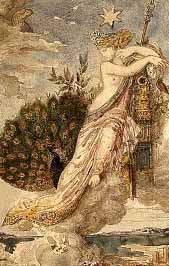
Today many people consider the month of June, which is named after the Goddess, to be the most favorable month for marriage. As the patroness of marriage, Juno restores peace between quarreling couples. One of her temples was used as a sanctuary for women who needed shelter from cruel husbands. Juno can be invoked in any rituals designed to restore a sense of self worth in women who have been abused in any fashion. Call Her when you need reassurance that women are ALWAYS worthy of the highest forms of respect.
"Drawing of Juno"
As one of the Roman representatives of the Triple Goddess, Juno reresents the Mother, the Full Moon. Juno is worshipped as the giver of light on the night of the full moon. Round and full like a woman's womb carrying a child, Roman women thought bearing children to be the Goddess’s greatest concern. Accordingly, all newborn children were said to be blessed and guarded by Juno.
Juno is one of the most powerful of the Roman goddesses. She is second in power only to Jupiter, her husband and according to some legends, her brother. She was the goddess of women, particularly married women. Serving as a guardian to women she oversaw all aspects of a woman's life, childbirth, and marriage being the primary areas of concern.
Her children Mars, Hebe, and Vulcan, were lesser gods in their own right. Juno was noted for her husband's affairs and her jealous reaction to them. She persistently tormented the offspring of his infidelities. Hercules and Perseus were two of the unfortunate victims of Juno's jealousy. Juno's Greek counterpart is the well-known Hera. Juno can also be invoked in rituals designed to right the wrongs against women, although it is always best to consider repercussions when calling Her for this type of ritual.
Juno was adamant that fidelity was a part of marriage, and she would not tolerate infidelity.
|
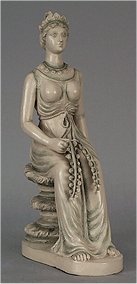 Juno and Her Symbols
Juno and Her Symbols
Juno is represented in statues, and other art forms as a tall statuesque woman with a severe beauty and a slightly militaristic bearing. She is the Goddess of light and beauty, the matron's goddess. A guardian angel to the women of the world.
Among Juno's sacred symbols were the peacock and the cowry shell, and of course the lily, or lotus, universal yonic emblem. With her sacred lily, Juno conceived the god Mars without any assistance from her consort, Jupiter; thus she became the Blessed Virgin Juno. The three-lobed lily that used to represent her parthenogenic power was inherited by the virgin Mary, who still retains it.
Worshipping Juno Today:
Every year, on the first of March, the matrons of Rome held a special festival called the Matronalia to praise Juno and thank her for her help. During this festival they asked the Goddess to bless their marriages and help them give birth to happy babies.
September 13th - LECTISTERNIUM. The Romans on occasion of extraordinary solemnities placed images of the gods reclining on couches, with tables and viands before them, as if they were really partaking of the things offered in sacrifice. This ceremony was called a lectisternium. At the Epulum Jovis, which was the most noted lectisternium at Rome, and which was celebrated in the Capitol, the statue of Jupiter was laid in a reclining posture on a couch, while those of Juno and Minerva were seated on chairs by his side; and this distinction was observed in allusion to the ancient custom, according to which only men reclined and women sat at table.
"A statue of Juno from JBL Statues"
|
Sacred to Her:
Day of the Week:
Thursday
Associated Goddesses:
Hera
Planet:
Jupiter
 Juno's Symbol (Jupiter)
Juno's Symbol (Jupiter)
|
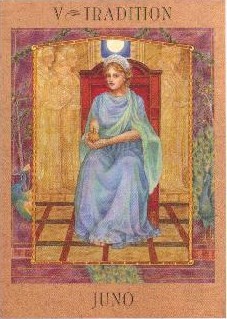 Tarot drawing of Juno created by Kris Waldherr
Tarot drawing of Juno created by Kris Waldherr
|
Zodiac Sign:
Sagittarius
Color:
Deep blue, royal purple
Elements:
Air, Fire
Moon Phase:
Full moon; Mother phase
|
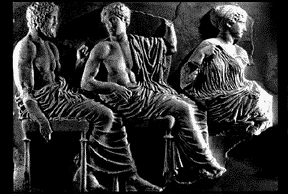 Ancient Roman wall showing Juno
Ancient Roman wall showing Juno
|
Plants:
grimony, anise, ash, balm, betony, blood root, borage, cinquefoil, clover, dandelion, hyssop, juniper berries, linden, mint, mistletoe, nutmeg, sage
Incense:
Cedar, nutmeg
Gemstones:
Amethyst, chrysolite, sapphire, or turquoise
Animal:
Unicorn
|
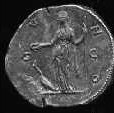 Ancient Roman coin depicting Juno
Ancient Roman coin depicting Juno
|
RITUAL and CHANT:
|
|
|
|
Ritual for Releasing a Relationship
Write on the left hand side of a paper the good things about the relationship.
Write on the right hand side of a paper the difficult or negative things.
Tear the paper in half. On the right side, write both your names. Keep the left side and set it aside. Bring your favorite magic crystal, rock, or stone, as well as a small bad of cornmeal to a special outdoor spot that you feel is "your spot".
Crumple the right side of the paper in your hand.
Make a circle with salt, nine feet in diameter. Inside this circle, burn the paper you have crumpled. Scoop up the ashes and put them in a small container of some kind.
Do an offering in the five directions. Talk to the spirit of the person. release them, but leave the door open so they might come when you call. Take a handful of cornmeal and the ashes. Twirl in a circle three times. The last time let out a yell and throw the handful as far as you can.
Leave - don't look back.
For seven days read the good things about the relationship that you have kept and set aside. At the end of this time, dispose of the paper in any way, except burning. |
|
CHANT:
Celebrate the heroine, honor the heroine:
Healer, thinker, adventurer, fighter,
Wise woman, strong woman, life-giving woman,
Woman of spirit, woman of power, woman of peace.
All hail, all honor, blessed be. |
Sources:
Books:
The Book of Goddesses Kris Waldherr (1995)
The Women's Encyclopedia of Myths and Secrets Barbara Walker
The Ancient Shining Ones D. J. Conway
The Goddess Book of Days Diane Stein
Goddess Spirituality Book: Rituals, Holydays and Moon Magic Ffiona Morgan
Internet Sites:
http://www.i5ive.com/article.cfm/10134/73703
http://www.cadvision.com/calcoin1/reference/myth/myjuno.htm
http://www.ukans.edu/history/index/europe/ancient_rome/E/Roman/Texts/secondary/SMIGRA*/Lectisternium.html(no longer active)
http://www.likeacat.com/msg11.htm
http://www.angelfire.com/oh/PristinePath/corr.html
|

